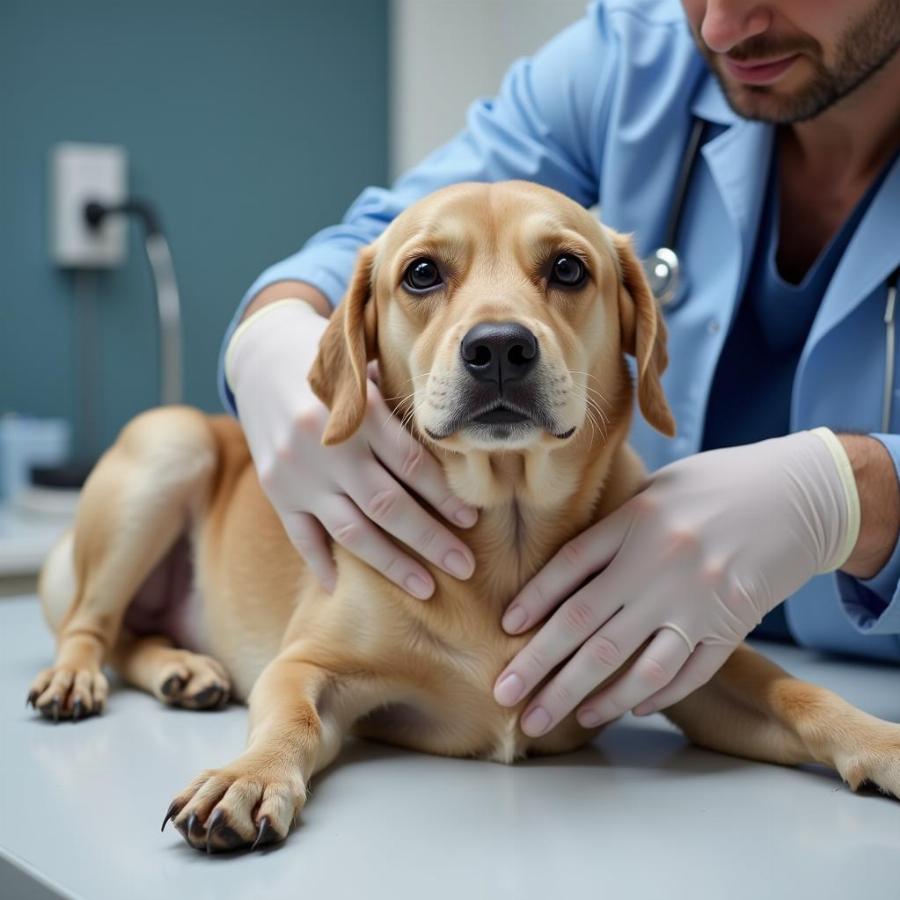Spayed scars on dogs are a common concern for many pet owners. This article provides a comprehensive guide to understanding what to expect from your dog’s spay incision, how to care for it, and when to seek veterinary attention. We’ll cover everything from the initial healing process to potential complications, empowering you to provide the best possible care for your furry friend after their spay surgery.
What to Expect from Your Dog’s Spay Scar
A spay surgery, also known as an ovariohysterectomy, involves removing a female dog’s ovaries and uterus. This procedure leaves a small incision on your dog’s abdomen, typically just below her belly button. The incision is usually closed with sutures, either dissolvable or non-dissolvable, and sometimes surgical glue or staples.
The appearance of the spayed scar varies depending on the surgical technique used and your dog’s individual healing process. Initially, the incision area might appear slightly red and swollen. Over time, the redness should subside and the scar will gradually fade.
 Veterinarian examining a dog's spay incision
Veterinarian examining a dog's spay incision
The healing process usually takes about 10-14 days. During this time, it’s crucial to prevent your dog from licking or biting the incision site, as this can introduce infection and disrupt healing. Your veterinarian will likely provide an Elizabethan collar (also known as a “cone of shame”) to prevent this.
Caring for Your Dog’s Spay Incision
Proper care of the spay incision is essential for preventing complications and promoting healing. Keep the area clean and dry. Avoid bathing your dog during the healing period unless instructed otherwise by your vet. Monitor the incision for any signs of infection, such as excessive redness, swelling, discharge, or a foul odor.
How do I know if my dog’s spay incision is infected?
Signs of infection include increased redness, swelling, pus, a foul odor, and excessive licking or chewing at the incision. If you notice any of these signs, contact your veterinarian immediately.
When can I remove my dog’s cone after spaying?
Typically, the cone should remain on for 10-14 days, or until the incision is fully healed. Consult your veterinarian for specific recommendations based on your dog’s individual case.
Potential Complications of Spay Scars
While most dogs heal without incident, some potential complications can arise. These include infection, seroma formation (fluid buildup under the skin), and dehiscence (opening of the incision). dog spaying scar provides more detailed information on these complications and what to do if they occur.
What does a healed spay scar look like on a dog?
A healed spay scar should appear as a thin, pale line. It may be slightly raised or indented. Some dogs’ fur may grow back differently around the scar area.
Conclusion
Understanding spayed scars on dogs is an important part of responsible pet ownership. By monitoring your dog’s incision, providing proper care, and knowing when to seek veterinary attention, you can ensure a smooth recovery and minimize the risk of complications. Remember to always consult your veterinarian if you have any concerns about your dog’s spay scar. how do you know if a female dog is fixed can offer further insights into confirming a successful spay procedure.
FAQs
- How long does it take for a spay scar to heal? Typically, 10-14 days.
- What should I do if my dog licks her spay incision? Use an Elizabethan collar to prevent licking and contact your vet.
- Is it normal for a spay scar to be red? Some redness initially is normal, but excessive redness could indicate infection.
- When should I call the vet about my dog’s spay incision? If you notice excessive redness, swelling, discharge, or a foul odor.
- Can my dog get pregnant after being spayed? No, spaying removes the ovaries and uterus, preventing pregnancy.
- Will my dog’s personality change after being spayed? Spaying generally doesn’t significantly alter a dog’s personality.
- How can I make my dog comfortable after spaying? Provide a quiet, comfortable place to rest and follow your vet’s pain medication instructions.
Beaut Dogs is your trusted source for all things dog-related, offering comprehensive information on dog breeds, care, and more. For further assistance, please contact us at Email: [email protected] to receive detailed and accurate answers from Beaut Dogs. Beaut Dogs is committed to empowering dog owners with the knowledge they need to provide the best possible care for their canine companions.